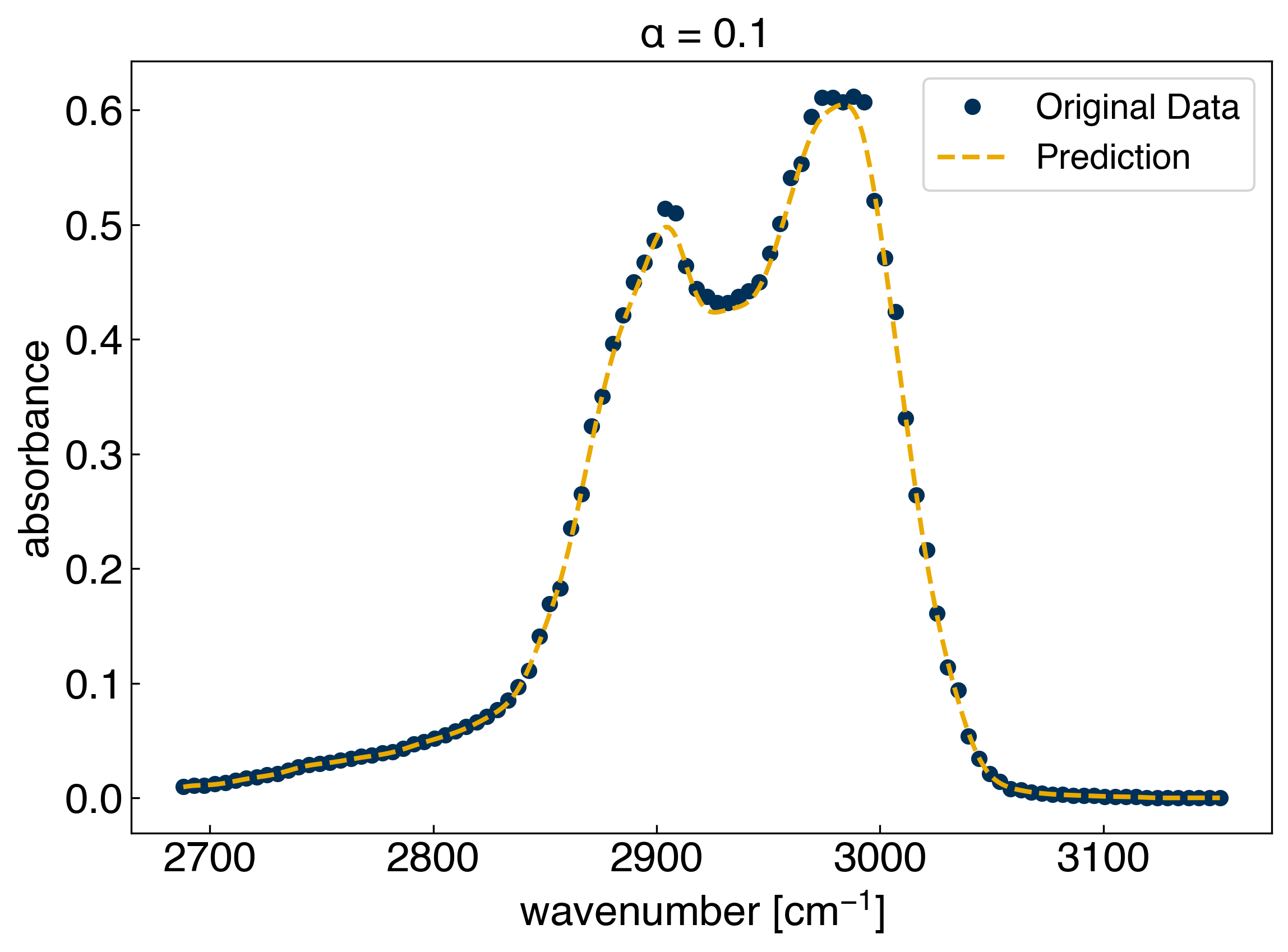%matplotlib inline
import matplotlib.pyplot as plt
plt.style.use('../settings/plot_style.mplstyle')
7.3. Complexity Optimization#
The key to machine learning is creating models that generalize to new examples. This means we are looking for models with enough complexity to describe the behavior, but not so much complexity that it just reproduces the data points.

Underfitting: The model is just “guessing” at the data, and will be equally bad at the data it has been trained on and the data that it is tested on.
Overfitting: The model has memorized all of the training data, and will be perfect on training data and terrible on testing data.
Optimal complexity: The model has learned from the training data and can generalize to the training data. The performance should be approximately as good for both sets.
Consider the general form of a machine-learning model introduced earlier:
\(\vec{y} = f(\vec{x}, \vec{w}(\vec{\eta}))\)
The “complexity” of a model is defined by its hyperparameters (\(\vec{\eta}\)). The goal of machine learning is to optimize the complexity of a model so that it generalizes to new examples. In order to achieve this goal we first need a way to quantify complexity so that we can optimize it.
In general there are a few strategies:
Number of parameters: “Complexity” varies linearly with number of parameters
Information criteria: “Complexity” varies with number of parameters and is balanced by the model error.
“Smoothness”: “Complexity” is related to the maximum curvature of the model
”With four parameters I can fit an elephant, and with five I can make him wiggle his trunk.”
- John von Neumann -
(see an example here)
7.3.1. Information Criteria#
The idea behind an “information criterion” is that it quantifies the tradeoff between the number of parameters and the model error. The most commonly used information criterion is the “Bayesian Information Criterion”, or BIC. The derivation of the BIC is beyond the scope of this course, but conceptually a lower BIC corresponds to a more probable model.
If we assume that our error is normally distributed, the BIC can be easily computed as:
\( BIC = n\times\ln{(\sigma^2_e)} + k\times\ln(n)\)
where \(n\) is the number of data points, \(\sigma_e\) is the standard deviation of the error, and \(k\) is the number of parameters.
There are a few other “information critera”, with the Akaike Information Criterion, or AIC, being the other most commonly used. For now we will just consider the BIC, but they typically yield similar optimal models.
Let’s implement the BIC in Python:
def BIC(y, yhat, k):
err = y - yhat
sigma = np.std(np.real(err))
n = len(y)
B = n*np.log(sigma**2) + k*np.log(n)
return B
Now we will apply it to models with the spectra dataset:
import numpy as np
import pandas as pd
df = pd.read_csv('data/ethanol_IR.csv')
x_all = df['wavenumber [cm^-1]'].values
y_all = df['absorbance'].values
x_peak = x_all[475:575]
y_peak = y_all[475:575]
fig, ax = plt.subplots()
ax.plot(x_peak,y_peak, '-', marker='.')
ax.set_xlabel('wavenumber [cm$^{-1}$]')
ax.set_ylabel('absorbance');
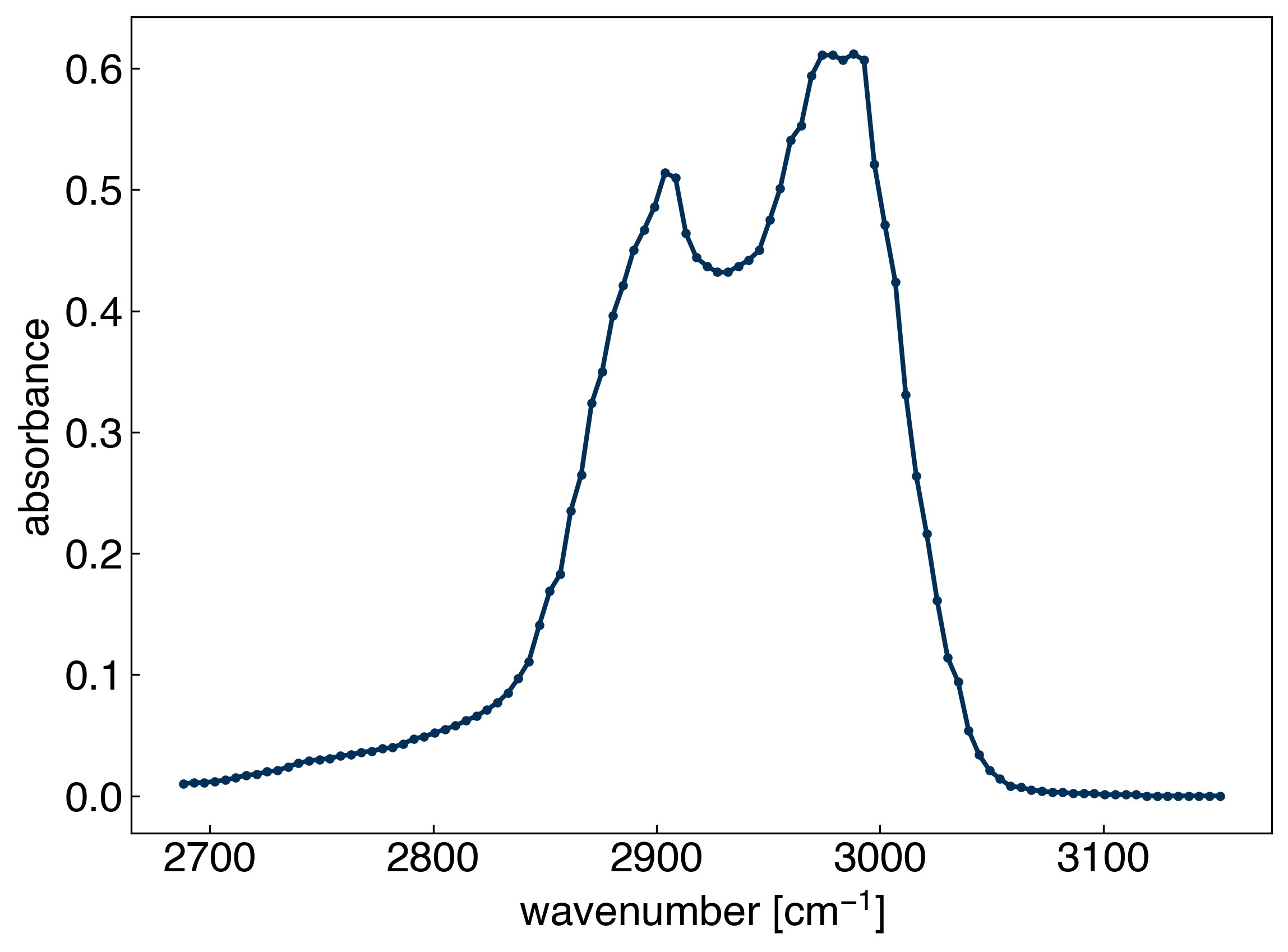
Now, let’s compare some of the many different models we have used for modeling the spectrum from the previous module and this module. We will look at the following models:
Polynomial regression with 40 polynomials (40 parameters)
Gaussian regression 20 evenly-spaced Gaussians (20 parameters)
We will re-implement the polynomial and Gaussian regressions using scikit-learn to make things easier:
from sklearn.linear_model import LinearRegression
def polynomial_features(x, N):
# function to return a matrix of polynomials for x to order N
# One-liner uses "list comprehension" to iterate through range 0 - N (note N+1 since range function is not inclusive)
# The input, x, is raised to the power of N for each value of N
# The result is converted to an array and transposed so that columns correspond to features and rows correspond to data points (individual x values)
return np.array([x**k for k in range(0,N)]).T
N = 40
X_poly = polynomial_features(x_peak, N)
LR_poly = LinearRegression() #create a linear regression model instance
LR_poly.fit(X_poly, y_peak) #fit the model
yhat_poly = LR_poly.predict(X_poly)
BIC_poly = BIC(y_peak, yhat_poly, N)
print(BIC_poly)
-283.0752960301787
def gaussian_features(x, N , sigma = 25):
# x is a vector
# sigma is the standard deviation
xk_vec = np.linspace(min(x), max(x), N)
features = []
for xk in xk_vec:
features.append(np.exp(-((x - xk)**2/(2*sigma**2))))
return np.array(features).T
N = 20
X_gauss = gaussian_features(x_peak, N)
LR_gauss = LinearRegression() #create a linear regression model instance
LR_gauss.fit(X_gauss, y_peak) #fit the model
yhat_gauss = LR_gauss.predict(X_gauss)
BIC_gauss = BIC(y_peak, yhat_gauss, N)
print(BIC_gauss)
-896.252613200568
fig, axes = plt.subplots(1,2, figsize = (15, 6))
axes[0].plot(x_peak, y_peak, '.')
axes[1].plot(x_peak, y_peak, '.')
axes[0].plot(x_peak, yhat_poly, '--')
axes[1].plot(x_peak, yhat_gauss, '--')
for ax in axes:
ax.set_xlabel('wavenumber [$cm^{-1}$]')
ax.set_ylabel('absorbance')
ax.legend(['Original Data', 'Prediction'])
axes[0].set_title('Polynomial Regression w/ n = 40')
axes[1].set_title('Gaussian Regression w/ n = 20');
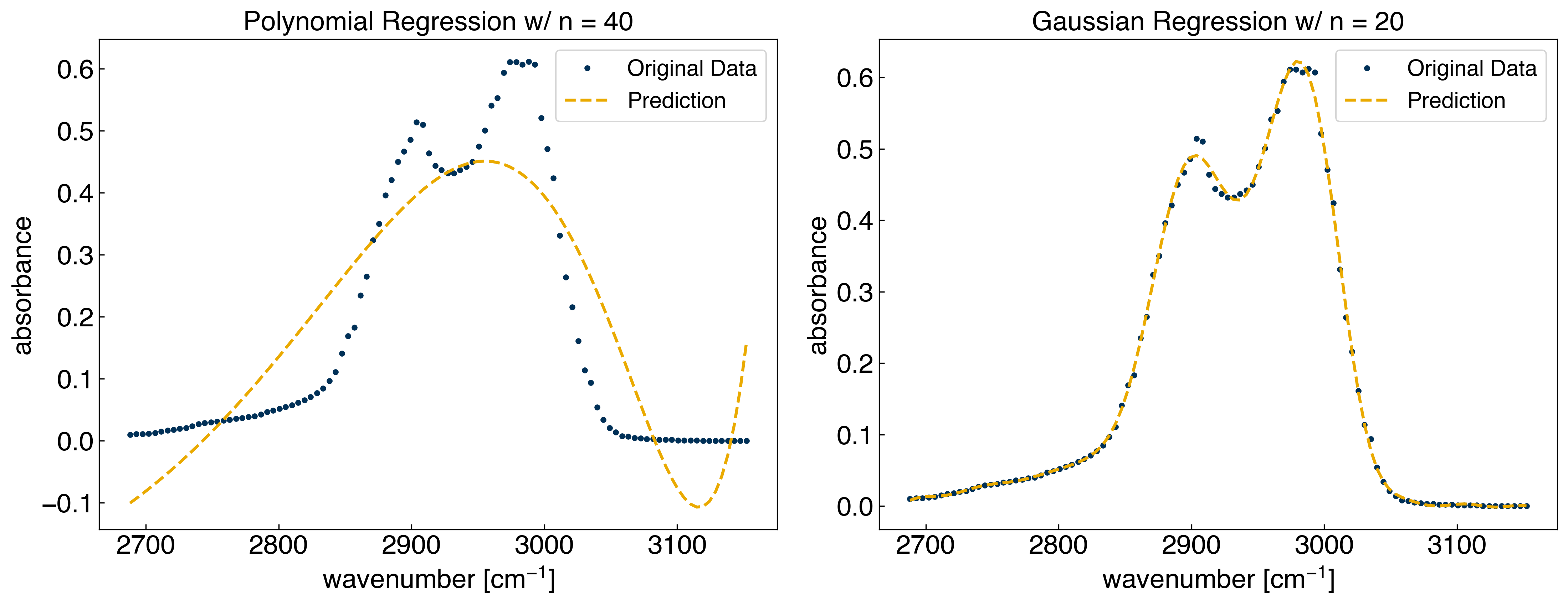
We can see that the BIC correctly predicts that the Gaussian model is preferred.
There are numerous other “information criteria” that can be used in a similar way. Another common one is the “Aikake information criterion”:
\( AIC = 2\times(\ln{(\sigma^2_e)} + k)\)
This is derived from a slightly different set of statistical assumptions. There are other criteria as well, and you can find them in the statistical literature if needed. However, it can often be very challenging to determine if your dataset fits the assumptions of the criteria, and in practice it is common to just use BIC. However, without knowing the details of the statistical assumptions these are not rigorous and should not be used as a substitute for common sense or intuition. However, the general idea of balancing number of parameters and model error provides a solid framework for thinking about complexity optimization.
One other challenge with information criteria is that non-parametric models have parameters that are not defined in the same way (the parameters and their values change depending on the training data). This makes it difficult (or impossible) to apply information critera with non-parametric models.
7.3.2. Regularization#
Another way of penalizing complexity is by trying to penalize models that change very sharply. This is achieved by adding a penalty for parameters with very large values in the loss function. For example:
\(L = \sum_i \epsilon_i^2 + \alpha \sqrt{\sum_j w_j^2}\)
In this case, we introduce a new hyperparameter, \(\alpha\), which controls the strength of regularization. We also choose to regularize on the square root of the sum of squared parameters, which is often called the “L2 norm” and written as:
\(L = \sum_i \epsilon_i^2 + \alpha ||\vec{w}||_2\)
We can also regularize in other ways, which can have advantages in some cases. We will discuss this more later, but will focus on the L2 norm for now.
7.3.2.2. Discussion: What happens as \(\alpha \rightarrow\) 0 and \(\alpha \rightarrow\) \(\infty\)?#
\(\alpha \rightarrow\) 0: no regularization
\(\alpha \rightarrow \infty\): flat line
We see that the regularization clearly affects the model, but sometimes it seems to make it worse. We need some strategy for assessing what value of regularization to choose. We can go back to the idea of cross-validation to achieve this:
from sklearn.model_selection import train_test_split
np.random.seed(0)
x_train, x_test, y_train, y_test = train_test_split(x_peak, y_peak, test_size=0.4)
fig, ax = plt.subplots()
ax.plot(x_train, y_train, 'o')
ax.plot(x_test, y_test, 'o', markerfacecolor='none');
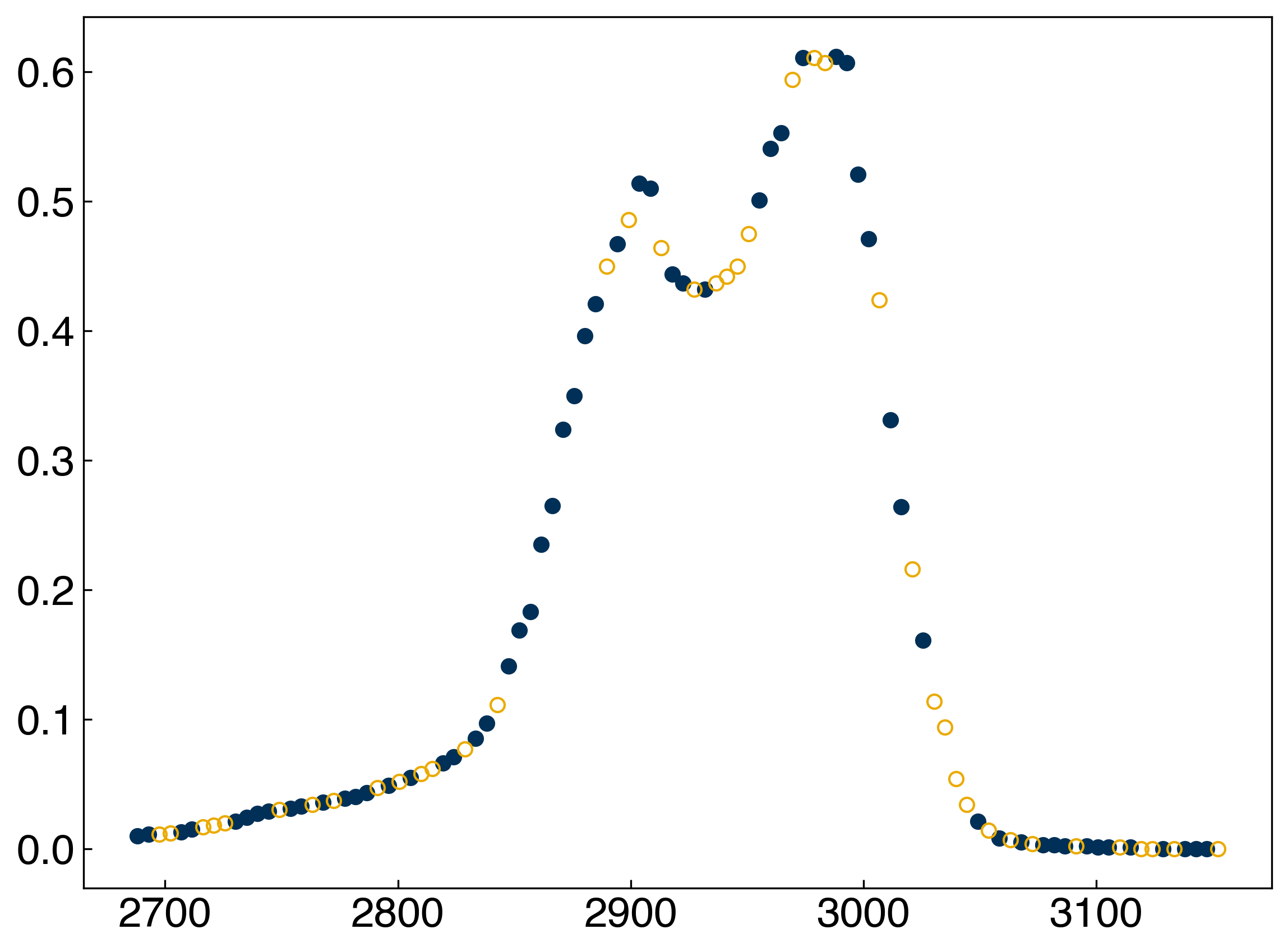
We can use hold out to compute the error on the testing data as we vary the regularization strength:
sigma = 10
gamma = 1. / 2 / sigma**2
alpha = 1e-3
KRR = KernelRidge(alpha=alpha, kernel='rbf', gamma=gamma)
KRR.fit(x_train, y_train)
x_predict = np.linspace(min(x_peak), max(x_peak), 300) #create prediction data
yhat_KRR = KRR.predict(x_predict)
r2_test = KRR.score(x_test, y_test)
print('r2 on the test set: {}'.format(r2_test))
fig, ax = plt.subplots()
ax.plot(x_train, y_train, 'o')
ax.plot(x_test, y_test, 'o');
ax.plot(x_predict, yhat_KRR, '--', markerfacecolor='none')
ax.set_xlabel('wavenumber [$cm^{-1}$]')
ax.set_ylabel('absorbance')
ax.legend(['Training Data', 'Testing Data', 'Prediction'])
ax.set_title(r'$\alpha$ = {}'.format(alpha));
r2 on the test set: 0.9816791895375319
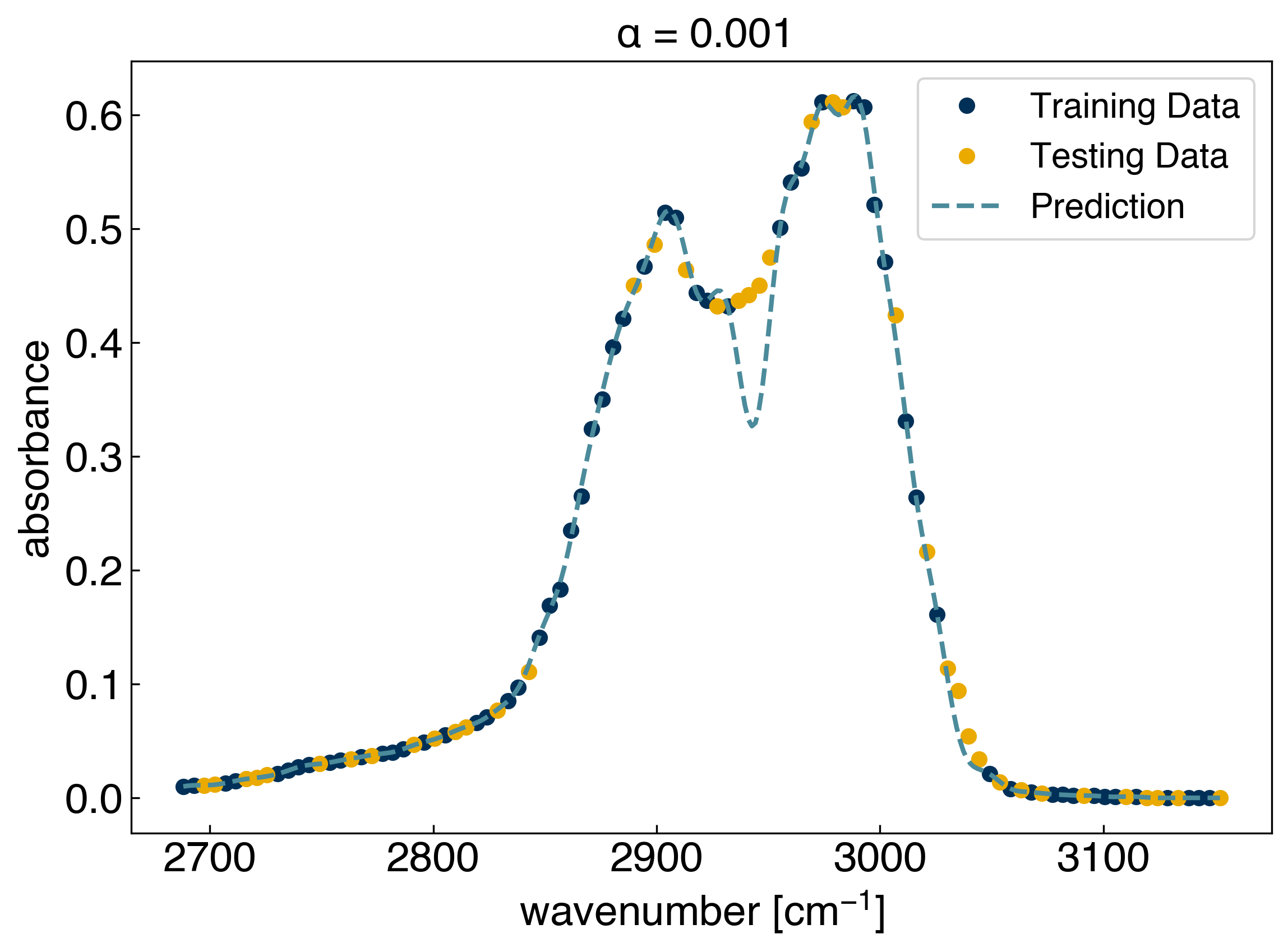
You can also see how the regularization affects the parameters, \(\vec{w}\), by looking at the (not intuitively named) dual_coef_ attribute of the KRR model:
coeffs= KRR.dual_coef_
print('The model has {} coefficients.'.format(len(coeffs)))
fig, ax = plt.subplots()
ax.hist(coeffs)
ax.set_xlabel('Coefficients')
ax.set_ylabel('Counts')
print('The largest coefficient is {:.3f}.'.format(max(abs(coeffs))[0]));
The model has 60 coefficients.
The largest coefficient is 10.984.
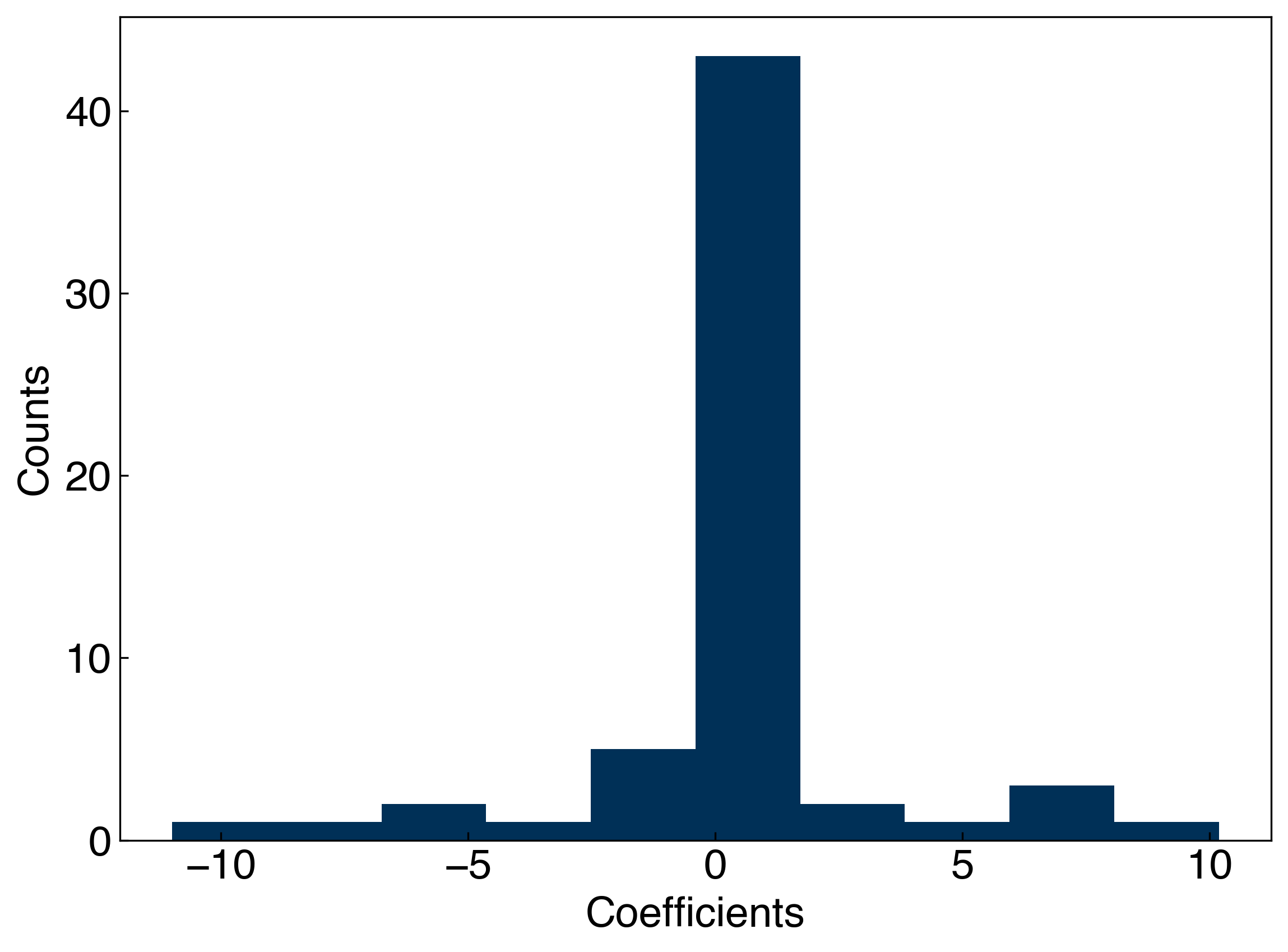
7.3.3. LASSO Regularization#
Ridge regression provides a good way to penalize model “smoothness”, but it doesn’t actually reduce the number of parameters. We can see that all of the coefficients are non-zero:
nonzero = [f for f in np.isclose(coeffs,0) if f == False]
print('Total number of non-zero parameters: {}'.format(len(nonzero)))
Total number of non-zero parameters: 60
Ideally we could also use regularization to reduce the number of parameters. It turns out that this can be achieved using the L1 norm:
\(||L_1|| = \sum_i |w_i|\)
where \(|.|\) is the absolute value. This is called “least absolute shrinkage and selection operator” regression, which is a terrible name with a great acronym: LASSO. The loss function for LASSO is defined as:
\(L_{LASSO} = \sum_i \epsilon_i^2 + \alpha ||\vec{w}||_1\)
This can be compared to the loss function for ridge regression:
\(L_{ridge} = \sum_i \epsilon_i^2 + \alpha ||\vec{w}||_2\)
We will not go through the derivation of why the L1 norm causes parameters to go to zero, but the following schematic, borrowed from this website may be useful (note that \(\vec{\beta}\) is equivalent to \(\vec{w}\):
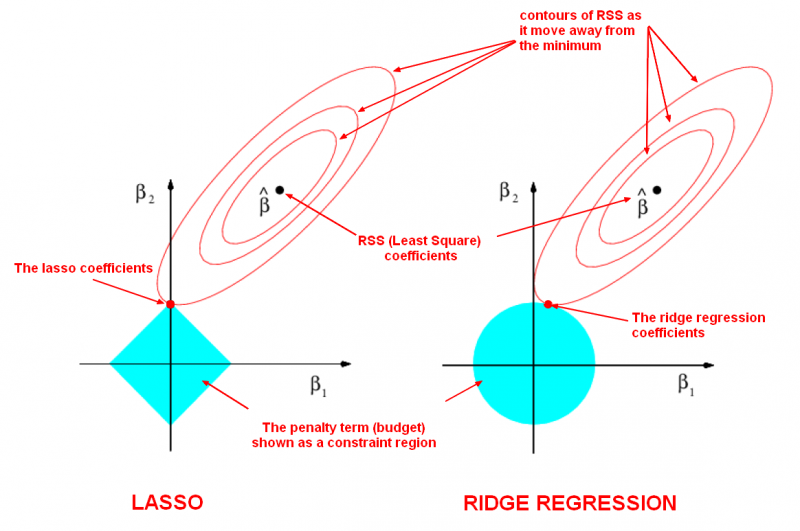
We can also test it using scikit-learn. Unfortunately, we need to create our own feature (basis) matrix, \(X_{ij}\), similar to linear regression, so we will need a function to evaluate the rbf. Instead of using our own, we can use the one from scikit-learn:
from sklearn.metrics.pairwise import rbf_kernel
sigma = 10
gamma = 1./(2*sigma**2)
X_train = rbf_kernel(x_train, x_train, gamma=gamma)
from sklearn.linear_model import Lasso
sigma = 10
gamma = 1./(2*sigma**2)
alpha = 1e-4
LASSO = Lasso(alpha=alpha)
LASSO.fit(X_train, y_train)
print('The number of coefficients: {}'.format(len(LASSO.coef_)))
x_predict = np.linspace(min(x_peak), max(x_peak), 300) #create prediction data
X_predict = rbf_kernel(x_predict, x_train, gamma=gamma)
yhat_LASSO = LASSO.predict(X_predict)
fig, ax = plt.subplots()
ax.plot(x_train, y_train, 'o')
ax.plot(x_test, y_test, 'o')
ax.plot(x_predict, yhat_LASSO, '--')
ax.set_xlabel('wavenumber [$cm^{-1}$]')
ax.set_ylabel('absorbance')
ax.legend(['Training Data', 'Testing Data', 'Prediction'])
ax.set_title(r'$\alpha$ = {}'.format(alpha));
The number of coefficients: 60
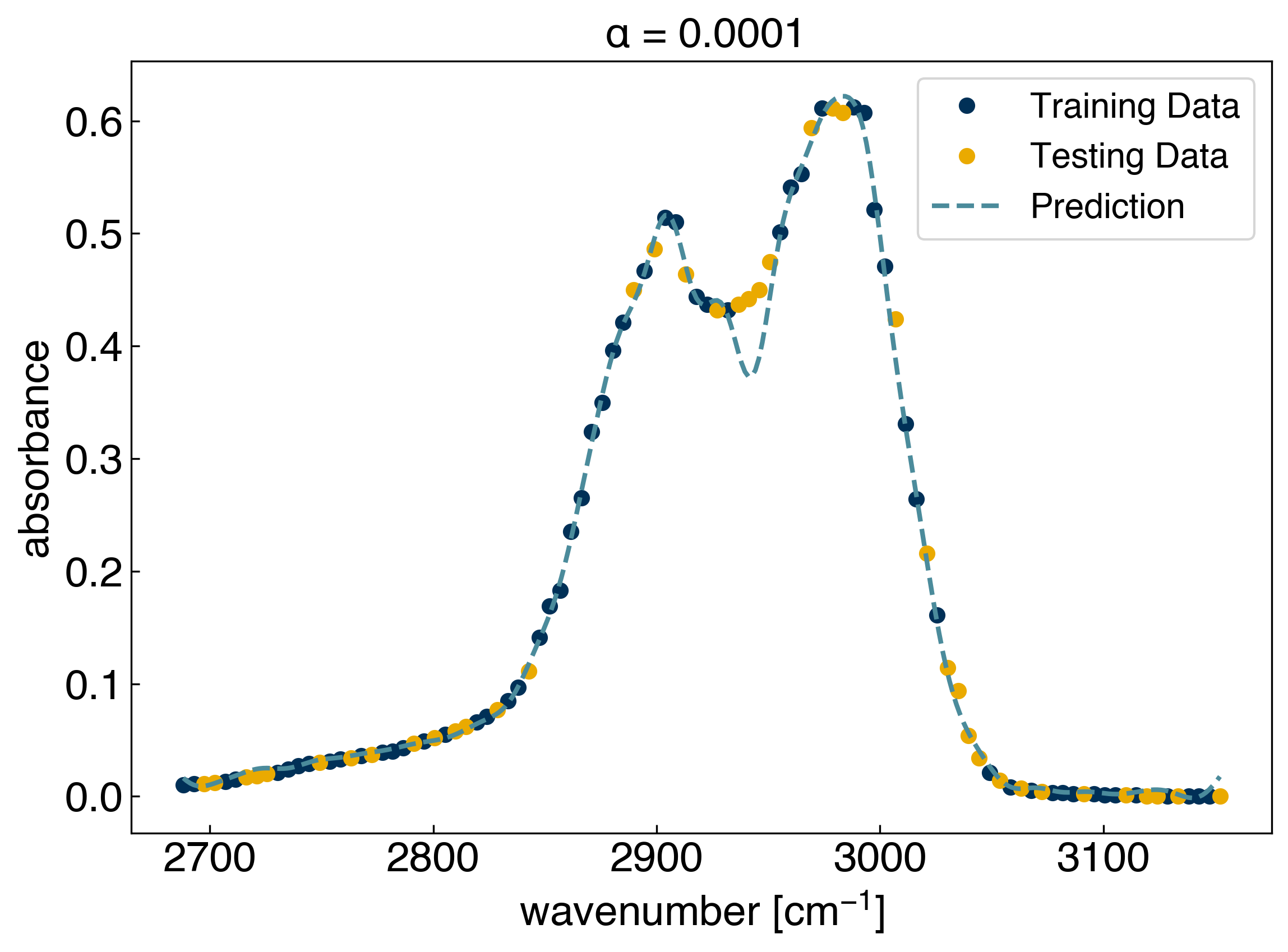
The results look similar to KRR. Now we can see how many non-zero parameters there are, and check the parameter values:
coeffs = LASSO.coef_
fig, ax = plt.subplots()
ax.hist(coeffs)
ax.set_xlabel('Coefficients')
ax.set_ylabel('Counts')
nonzero = [f for f in np.isclose(coeffs,0) if f == False]
print('Total number of non-zero parameters: {}'.format(len(nonzero)))
Total number of non-zero parameters: 41
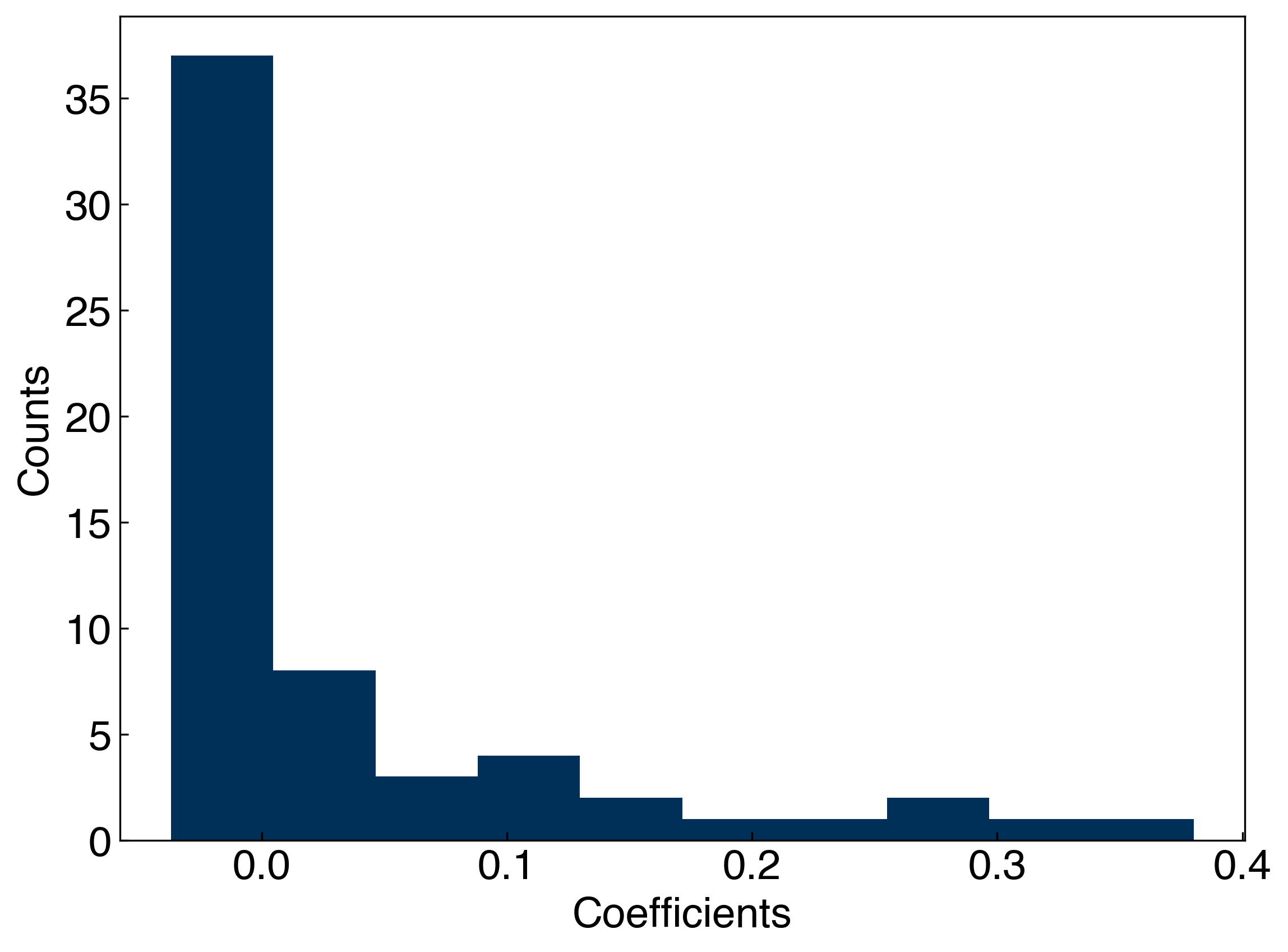
We see that the LASSO regularization has a lot of coefficients that are equal to zero. This is equivalent to discarding these terms and finding which Gaussians should (or should not) be included.
7.3.4. Hyperparameter Tuning#
The KRR and LASSO models above have 2 hyperparameters: \(\gamma\) \(\left(=\frac{1}{2\sigma^2}\right)\) and \(\alpha\). So far, we have optimized \(\alpha\), but the model performance (and optimal \(\alpha\)) will also depend on \(\sigma\). You can probably see that optimizing these will get rather tedious.
Fortunately, scikit-learn has some nice built-in tools to help. The most commonly used is GridSearchCV, which is a brute-force approach that searches over a grid of hyperparameters, and uses cross-validation at each grid point to assess model performace.
Here we will use GridSearchCV to find the optimum KRR model and its score (related to \(R^2\)):
from sklearn.model_selection import GridSearchCV
sigmas = np.array([5, 10, 15, 20, 25, 30,35, 40])
gammas = 1./(2*sigmas**2)
alphas = np.array([1e-9, 1e-5, 1e-4,1e-3, 1e-2,1e-1, 1])
parameter_ranges = {'alpha':alphas, 'gamma':gammas}
KRR = KernelRidge(kernel='rbf')
KRR_search = GridSearchCV(KRR, parameter_ranges, cv=3)
KRR_search.fit(x_train,y_train)
KRR_search.best_estimator_, KRR_search.best_score_
(KernelRidge(alpha=0.01, gamma=0.0005555555555555556, kernel='rbf'),
0.9953287405140007)
This tells us that the best performance comes from a model with \(\alpha=0.01\) and \(\gamma=0.000555\). We can check the performance of the model:
yhat_KRR = KRR_search.best_estimator_.predict(x_predict)
fig, ax = plt.subplots()
ax.plot(x_train, y_train, 'o')
ax.plot(x_test, y_test, 'o')
ax.plot(x_predict, yhat_KRR, '--', markerfacecolor='none')
ax.set_xlabel('wavenumber [$cm^{-1}$]')
ax.set_ylabel('absorbance')
ax.legend(['Training Data', 'Testing Data', 'Prediction'])
ax.set_title(r'$\alpha$ = {}, $\gamma$ = {:.6f}'.format(KRR_search.best_estimator_.alpha, KRR_search.best_estimator_.gamma));
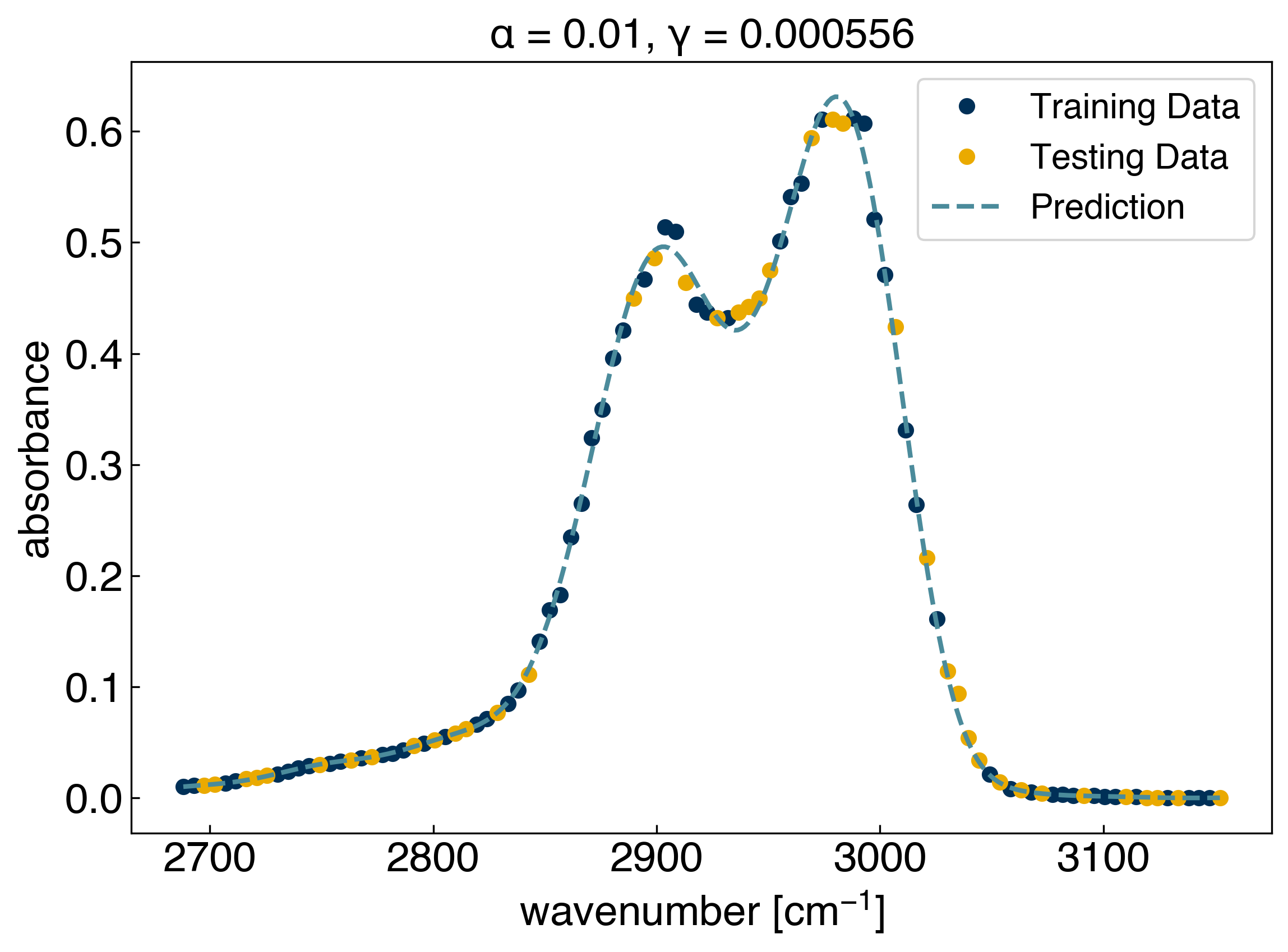
This is much faster than doing all the work yourself!
One note is that the best model will depend on the parameters you search over, as well as the cross-validation strategy. In this case, cv=3 means that the model performs 3-fold cross-validation at each gridpoint.

